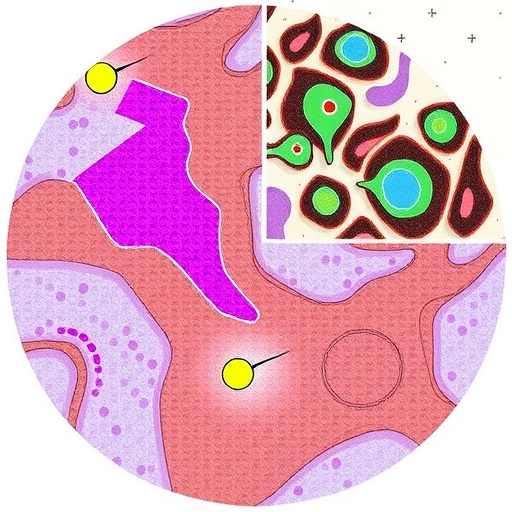
In a remarkable leap forward for diabetes research, a groundbreaking study published in Nature Communications has unveiled a previously obscure molecular mechanism that plays a vital role in preserving the function of islet β-cells in mice. At the heart of this discovery lies the intricate interaction between the E3 ubiquitin ligase March5 and the transcriptional co-repressor Trim28, where March5-mediated degradation of Trim28 emerges as a crucial process that maintains β-cell integrity and function. This finding promises to open novel therapeutic avenues for the treatment and management of diabetes, a chronic illness that affects hundreds of millions worldwide and stems from the dysfunction or loss of insulin-producing β-cells.
The pancreas’ islets of Langerhans contain β-cells responsible for synthesizing and secreting insulin, a hormone pivotal to glucose homeostasis and energy regulation. The gradual decline in β-cell functionality and mass is a hallmark of type 2 diabetes, often linked to cellular stress, chronic inflammation, and metabolic dysfunctions that culminate in β-cell apoptosis or dedifferentiation. Against this backdrop, the study led by Chen et al. offers a molecular insight into how the balance of protein regulation within β-cells can mitigate such detrimental pathways, thereby conserving endocrine function.
At the molecular level, March5 functions as a mitochondrial E3 ubiquitin ligase, traditionally recognized for its roles in mitochondrial dynamics and quality control. Trim28, on the other hand, is a transcriptional co-repressor implicated in chromatin remodeling and gene expression regulation, known to participate in various cellular stress responses. Through extensive experimentation, the researchers elucidated that March5 targets Trim28 for proteasomal degradation. This post-translational regulation dampens the repressive impact of Trim28 on essential genes that sustain β-cell survival and functionality.
.adsslot_5BR6ySU9tl{width:728px !important;height:90px !important;}
@media(max-width:1199px){ .adsslot_5BR6ySU9tl{width:468px !important;height:60px !important;}
}
@media(max-width:767px){ .adsslot_5BR6ySU9tl{width:320px !important;height:50px !important;}
}
ADVERTISEMENT
In murine models, the absence or inhibition of March5 led to an accumulation of Trim28 within β-cells. This accumulation triggered deleterious effects, including heightened cellular stress, impaired insulin secretion, and ultimately β-cell failure. Conversely, enhancing March5 activity or mimicking its effect through molecular interventions promoted the degradation of Trim28, thereby safeguarding β-cell health and maintaining glucose sensitivity. These mechanistic revelations pinpoint March5 as a protective agent within the cellular machinery that sustains insulin-producing cells amid metabolic challenges.
The study’s comprehensive approach intertwines in vivo analyses with in vitro cellular models, underscoring the physiological relevance of the March5-Trim28 axis. Using genetically modified mouse strains deficient in March5 specifically within β-cells, researchers observed pronounced glucose intolerance and diminished insulin secretion, hallmarks of β-cell dysfunction. Furthermore, islets isolated from these mice demonstrated increased markers of stress and perturbed gene expression linked with cell survival pathways. Restoration of March5 activity via genetic rescue experiments reversed these adverse phenotypes, solidifying the causal relationship.
Importantly, the researchers also dissected the downstream gene targets affected by Trim28’s repressive activity. Through chromatin immunoprecipitation sequencing (ChIP-seq) and transcriptomic analyses, they identified a cohort of genes vital for mitochondrial function, oxidative stress mitigation, and insulin processing that were suppressed when Trim28 levels were abnormally high. This suppression compromised the β-cell’s capacity to meet the insulin secretion demand under hyperglycemic conditions, a scenario reflective of metabolic stress in diabetes.
The implications of this study extend beyond fundamental cell biology into clinical realms. Since current diabetes treatments largely focus on managing blood glucose levels or enhancing insulin sensitivity, safeguarding β-cell health represents a more upstream and potentially curative strategy. Targeting the March5-Trim28 pathway might allow for selective modulation of β-cell resilience, preventing the progressive loss of these crucial cells that underlies disease progression. Small molecules or biologics designed to enhance March5 activity or inhibit Trim28 could form the basis of innovative therapeutic regimens.
Moreover, the mitochondrial localization of March5 introduces an intriguing link between mitochondrial quality control and transcriptional regulation in β-cells, indicating a multifaceted network governing cell survival. Mitochondrial dysfunction is a well-established contributor to β-cell failure, and this new mechanistic insight suggests that targeted enhancement of mitochondrial E3 ligase activity can confer broader protective effects by modulating nuclear gene expression regulators like Trim28. Such cross-talk between cellular compartments could redefine how researchers think about diabetes pathogenesis.
This research also raises important questions about the regulation of the March5-Trim28 axis under diabetic conditions or metabolic stress. For instance, it remains to be explored whether factors such as hyperglycemia, lipotoxicity, or pro-inflammatory cytokines impair March5 expression or function, thereby exacerbating β-cell vulnerability. Understanding these upstream modulators could help identify additional drug targets or biomarkers for early detection of β-cell stress before irreversible damage ensues.
The authors leveraged state-of-the-art proteomic techniques to quantify Trim28 ubiquitination, corroborating March5’s role as a bona fide E3 ligase mediating Trim28 turnover. Such methodological rigor strengthens the study’s conclusions and provides a template for future investigations into ubiquitin ligase-substrate relationships in endocrine tissues. Furthermore, these techniques could be adapted to study similar regulatory mechanisms in human islet cells, bridging the translational gap toward clinical application.
Notably, this discovery opens up the exciting possibility that manipulation of ubiquitin-mediated degradation pathways may serve broader therapeutic benefit across other diseases marked by aberrant protein accumulation and cellular dysfunction. The principle that carefully regulated proteostasis underpins cellular homeostasis is increasingly recognized, and the identification of March5’s specific target advances this paradigm within the context of β-cell biology.
The investigation touches upon the nuanced equilibrium between protein stability and degradation, highlighting how fine-tuning this balance can dramatically influence cell fate decisions. In the case of β-cells, Trim28’s degradation prevents the repression of gene networks necessary for metabolic adaptability, emphasizing the dynamic interplay between epigenetic modifiers and ubiquitin-proteasome system components in maintaining endocrine function.
Furthermore, this study adds to a growing body of literature illustrating that mitochondrial proteins carry regulatory responsibilities beyond energy metabolism, venturing into the realm of gene expression control and epigenetic regulation. By assigning regulatory significance to March5’s mitochondrial E3 ligase activity in preserving β-cell identity, the research enriches our understanding of organelle signaling integration.
Given the increasing global incidence of diabetes, particularly in young populations, the potential translational impact of such research is profound. Strategies enhancing endogenous β-cell preservation not only improve glycemic control but may also alleviate the long-term complications associated with insulin insufficiency. These insights imbue hope for long-term remission or even reversal of β-cell destruction through molecular interventions targeting the March5-Trim28 pathway.
In conclusion, the work by Chen and colleagues provides a compelling narrative of cellular resilience orchestrated at the molecular level within pancreatic β-cells. By delineating how March5 facilitates the selective degradation of Trim28 to preserve β-cell function, the findings unravel a novel axis of intracellular regulation with significant implications for diabetes treatment. As this field advances, further elucidation of related ubiquitin ligases and their targets will be imperative to harnessing these mechanisms for therapeutic gain, representing a vibrant frontier in metabolic disease research.
Subject of Research: Molecular mechanisms preserving islet β-cell function in mice, focusing on March5-mediated ubiquitination and degradation of Trim28.
Article Title: March5-mediated Trim28 degradation preserves islet β-cell function in mice.
Article References:
Chen, Y., Pang, W., Ma, G. et al. March5-mediated Trim28 degradation preserves islet β-cell function in mice. Nat Commun 16, 7073 (2025). https://doi.org/10.1038/s41467-025-62587-z
Image Credits: AI Generated
Tags: cellular stress and inflammationdiabetes researchglucose homeostasis and energy regulationinsulin-producing β-cellsMarch5 E3 ubiquitin ligasepancreatic islets functionprotein regulation in β-cellstherapeutic targets for diabetesTrim28 transcriptional co-repressortype 2 diabetes pathologyβ-cell integrity and functionβ-cell preservation mechanisms





